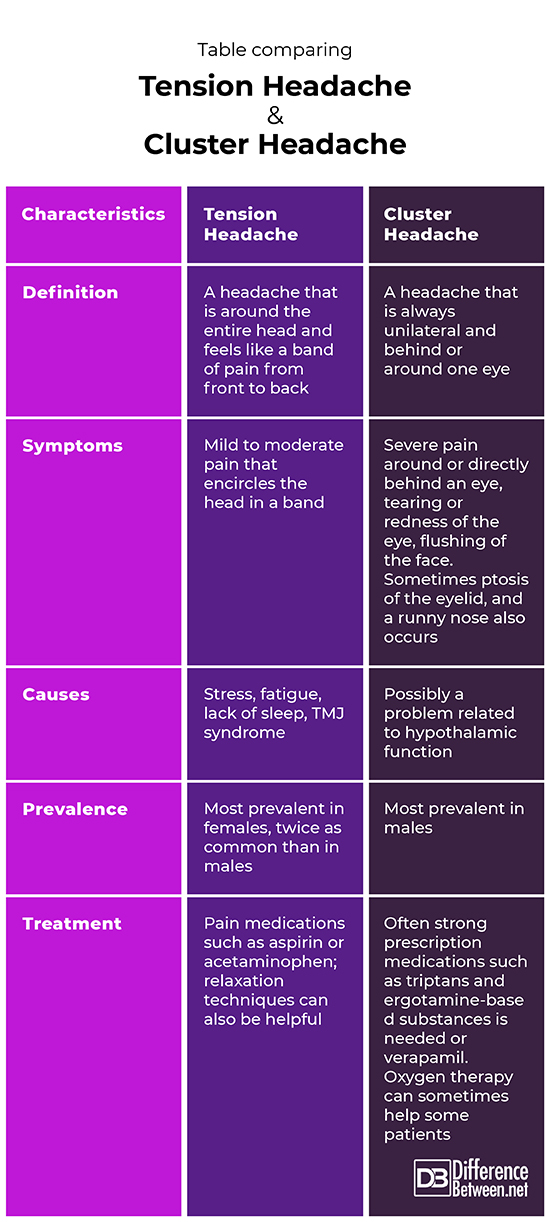Difference Between Tension Headache and Cluster Headache
A tension headache is a type of headache in which the pain is felt and spreads around the head from front to back. A cluster headache is a headache in which the pain is only focused around or at the back of one of the eyes.
What is Tension Headache?
Definition:
A tension headache is a type of headache in which the pain wraps around the head and can vary in severity from a mild ache to a more moderate feeling of discomfort.
Symptoms:
The symptoms of a tension headache include a widespread pain that appears to be in a band that goes around the entire head. It is often described as a dull aching pain that affects the forehead, sides, and the back part of the head. Pain and stiffness is sometimes also felt in the neck and shoulders. This type of headache can last for about 30 minutes to several hours depending on if it is an episodic or a continuous type of tension headache.
Diagnosis:
The diagnosis of a tension headache is based on the location and type of pain that is present; in addition the pain is not as severe as in other types of headaches such as migraine or cluster headache. Imaging tests can be done to rule out other causes of head pain.
Causes:
A tension headache is sometimes also called a stress headache as it can be precipitated by stressful events in one’s life. Other causes of a tension-type headache include a lack of sleep, and also fatigue. Potential triggers of this type of headache, besides what has already been mentioned, include problems with the temporomandibular joint (TMJ syndrome), eye strain and neck pain. Overwork and not getting enough sleep can precipitate this type of headache.
Treatment:
Generally, over the counter pain medications such as acetaminophen or aspirin are helpful in treating the pain. Learning ways to manage and alleviate stress and tension can also be helpful in preventing these headaches from occurring. Responses to different treatment methods vary a lot among individuals.

What is Cluster Headache?
Definition:
A cluster headache is a severe headache in which pain is focused either at the back or surrounding one eye, and the pain comes in weekly or monthly cycles.
Symptoms:
The symptoms include severe pain that is felt behind or surrounding the eye. The affected eye may also tear up or swell, and the face may flush on the affected side. There may also be ptosis, on the affected side. People may also experience a runny nose or congested nose, and often individuals feel restless. The pain of a cluster headache is very extreme and patients may need treatment at an urgent care center or hospital.
Diagnosis:
The symptoms usually lead to a diagnosis, particularly the severity of the pain and the location with respect to an eye, but imaging can rule out other possible conditions. This type of headache is also much more frequent in males than females.
Causes:
Scientists do not know why cluster headaches occur and even why they are more common in men. Researchers speculate that some problem with the hypothalamus in the brain may be involved in causing the condition.
Treatment:
Strong pain medicines such as ergotamine-based substances and triptans are often used. Verapamil and also prednisone can sometimes also be used to help treat the condition.
Difference between Tension headache and Cluster headache?
Definition
A tension headache is a headache that spans the entire head and feels like a band of pain from front to back. A cluster headache is always on one side only and behind or around one eye.
Symptoms
The symptoms of a tension headache include mild to moderate pain that encircles the head in a band. The symptoms of a cluster headache include severe pain located behind or surrounding an eye, facial flushing, tearing of the affected eye, ptosis, and runny nose.
Causes
A tension headache is caused by stress, fatigue, lack of sleep, and TMJ syndrome. A cluster headache is thought to possibly be caused or related to some issue with the hypothalamic region of the brain.
Prevalence
Tension headaches occur more frequently in females than males. Cluster headaches occur more often in males than females
Treatment
Non-prescription pain medicine such as aspirin or acetaminophen usually works for tension headaches, as well as various relaxation techniques that reduce stress. Cluster headaches are severe so prescription strength medicine is needed, including ergotamine-based derivatives, triptans, verapamil and sometimes, prednisone.
Table comparing Tension headache and Cluster headache

Summary of Tension Headache Vs. Cluster Headache
- Tension and cluster headaches both result in pain in the head.
- Tension headaches occur more often in women and feel like a band is placed around the head.
- Cluster headaches occur more often in men and they only occur around or directly behind an eye.
- Tension headaches seem to be caused by factors such as stress, exhaustion, lack of sleep and also problems with the temporomandibular joint.
- The causes of cluster headaches are not known, but scientists suspect it could be due to problems with the hypothalamus region of the brain.
- Difference Between Rumination and Regurgitation - June 13, 2024
- Difference Between Pyelectasis and Hydronephrosis - June 4, 2024
- Difference Between Cellulitis and Erysipelas - June 1, 2024
Search DifferenceBetween.net :
Leave a Response
References :
[0]Bogaards, Moniek C., and Moniek M. ter Kuile. "Treatment of recurrent tension headache: a meta-analytic review." The Clinical journal of pain (1994).
[1]Silberstein, Stephen D. “Cluster Headache”. Merckmanuals. Merck & Co., 2018, https://www.merckmanuals.com/professional/neurologic-disorders/headache/cluster-headache
[2]Silberstein, Stephen D. “Tension-Type Headache”. Merckmanuals. Merck & Co., 2020, https://www.msdmanuals.com/professional/neurologic-disorders/headache/tension-type-headache
[3]Image credit: https://commons.wikimedia.org/wiki/File:Cluster_headache_introductory_phase_2018-08-31_17.14.41.jpg
[4]Image credit: https://commons.wikimedia.org/wiki/File:Tension-headache.jpg
